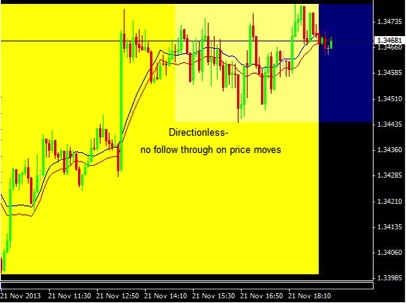The Trades You Don’t Take Determine Your Success
Traders are always looking for the next winning trade, but often it is the trades not taken that ultimately determine the success of a trader.
Some days have strong price trends, and the potential for winning trades–if you trade in the same direction as the trend–is quite high. Other days the price action is not as clear cut; it’s choppy and directionless. While it is possible to make money on such days, the odds are lower.
Instead of trying to make money on such days, the goal should be to minimize trades. On choppy days it’s possible to get many trade signals, yet few are likely to turn out well. Therefore, the goal is to minimize trades by only take trades with a high probability of working out, and quite often that will mean you may not make any trades at all.
In the quest to make a profit on a day with poor trading conditions, often the day ends of being a loser. Now you need a good day just to make back the losing day, when instead you could have avoided the losing day altogether.
November 21 provides an example in the EUR/USD. A price spike a couple hours before the US session set up an overall bullish tone, but after this market was unable to follow-through on any price moves.
Figure 1. EUR/USD – 5 Minute Chart

In figure 1 there is a price spike higher, which indicates looking for long positions is the ideal strategy. Yet, as the US session begins (pale yellow) the price is unable to make new highs. Therefore, the market has neither an upside nor downside bias–it is directionless.
Notice how the moves have no follow-through. A drop is not followed by another drop, but rather a reversal in the opposite direction; similarly, a rally is followed by a drop, and not another rally.
Trading in this type of environment can be difficult. Most days aren’t like this though, so opting not to trade when these conditions are present is usually a wise decision. It is better to wait until the price action is more directionally biased. During a trend the price moves in one direction, pulls back and then continues to move in that direction–making higher highs and higher lows in the case of an uptrend.
This allows for buying on pullbacks and locking in a profit on the next wave higher. In Figure 1 that doesn’t occur though. On a day like November 21 the challenge is to avoid making impulsive, low-probability trades that end up costing you money.
There weren’t any great opportunities during the portion of the US session shown in Figure 1, and that means you have preserved your capital for good opportunities that come along in the future.
It’s the trades you don’t take that usually determine your ultimate success. By preserving capital on days like these, you don’t need to make those loses back, and you don’t cut into profits you’ve already made.
Losing days do occur, but many losing days can be avoided by just looking at the overall structure of the day. If the conditions aren’t great, it’s best not to trade.